LAUNCHARI - The Pride of a Gaddan
For me what caught my attention was the beautiful
dress and jewellery of the Gaddan women and their smiles – definitely the most
colorful and beautiful in Himachal. The Gaddi jewellery is now the trade mark
of Himachal
With my interest in everything traditional; I obviously
yearned to wear it myself someday. The opportunity came when I visited Chamba
last year and my young sweet friend Shweta Devgan arranged the entire costume
for both of us and what an experience it turned out to be.
Now a little about Gaddis – who are they?
Gaddi is a semi pastoral nomadic tribe who mainly live
in Himachal and Jammu. They are basically transhumant with majority having
their homes in Bharmour (sub division of Chamba). With changing times some have
left their pastoral lifestyle and have joined government jobs and other
professions but still maintain their linkages with their tribe and their native
place. Gaddi is a generic term for variety of castes – mainly Brahmins and
Rajputs and some other castes as well. They migrate from higher altitude to
lower for want of better fodder as according to the weather conditions. Have
deep knowledge of mountain systems, medicinal herbs, local flora and fauna and
are quiet in sync with nature.
And where have they come from?
If we look into the history of Gaddis - there are
three or four theories about their origin, but the most accepted is that the
ancestors of the present day Gaddis probably were nomadic pastoral community of
Indian plains who mainly lived around Barmer area of Rajasthan. With Muslim
invasions increasing they initially took refuge in Kangra valley, but as Kangra
itself was not safe from Muslims; they probably crossed over to Chamba and
Bharmour and also to Jammu for a safer place to stay with their flock. Their
Rajasthan connect is very much evident in their dress – hand printed colorful
cloth, use of mirrors, embroidery, cowries and shells - so unlike rest of
Himachal.
Gaddis have many distinctive features to write about –
but this blog is dedicated to Launchari – the formal female attire of Gaddi
women and their jewellery.
Launchari and its uniqueness -
Gaddi women mostly wear salwar kameez – but their formal dress – Launchari - is simply gorgeous and unique and worn on all occasions – happy or sad. It is the dress for a married woman and is gifted from both sides - the bride and the groom's family. It is a full pleated long skirt or lehnga with a top of different color stitched to it as a one piece dress. The waist is accentuated with a black woolen rope – known as dori. The dress is ornamented with embroidered lace (earlier hand embroidery) and mirrors and shells. The Gaddi women wear it with lots of pride irrespective of the fact whether they are nomadic or not. It’s almost mandatory to wear it during weddings in the family.
Wearing it with full jewellery- the Gaddi women look like queens, they feel like queens of their homes and portray the deep bond of the community with their culture and heritage.
The full swirl of the skirt
Design and Fabric -
Though Bharmour is a cold area but Launchari mainly is made of cotton cloth with a particular style of prints. The reason as stated by historian
Mr. O. C. Handa, is that the ancestors of present day Gaddi women in their native
Rajasthan used a particular type of hand printed cotton fabric dyed by
Chhimbas caste of Barmer. With the exodus of Gaddi tribes, some of the Chhimbas
also moved and settled in Jammu region and also in Shapur – Hatli to cater to
the needs of Gaddi community. The Gaddi women are so fascinated by this hand
printed cloth that they use it for their traditional dress and why not –
for this provides them the uniqueness.
Launcharis are also made with woollen cloth and plain fabric for winters and for sad occasions. These are layered with colourful scarves and shawls.
The main parts of the dress are -
Skirt and top – made of cotton chintz and requires 11 to 21 meters depending on the swirl of the skirt. It is worn over the normal salwar kameez and during winters over a woolen salwar kameez. It is open from one side - length wise -and is adorned with lace.
Dora or Dori – is an
extraordinary part of this dress and is made of sheep wool and is hand woven.
It is also called Gatri. For a women it is almost 120-150 feet long and
weighs 1.5 kgs. It goes around the waist and requires help in tying it. This
rope is convenient for carrying loads on their backs, securing money bags in
it, tying sickle, hukka or flint. Also used for tying sheep and goats
together and other items. It keeps the back straight and stomach in. And most
important it has got religious value as well. The rope is taken as Shivari -
Seli (Shiva’s sign) and is auspicious.
Dori being tied around my waist
Chadru – mostly made of cotton – can be of any colour but red, pink and white are preferred.
Jutti – made of leather called Desi jutta.
Chamba chappals are also worn.
Launchari can be seen in the miniature paintings of
Chamba and Kangra, in Chamba Roomal and paintings of Sir Sobha Singh. The most
prominent of Gaddan image from history is of Nokhu Gaddin whose beauty captivated
the Katoch King Raja Sansar Chand’s heart and he married her. Their standing image can be seen
in the fort of Sujan Pur Tira’s temple – representing Shiva and Parvati.
Jewellery –
Gaddi women have an inherent love for jewellery and
have the most elaborate and gorgeous jewellery in Himachal. Silver, gold,
precious and semi-precious stones and enamel work is the main stay of
jewellery. The designs are mainly drawn from the nature and from all the places
they wander into.
Head Ornaments – Chak, Chiri, jinjroo, Litki, Nam
Tikka
Ears – Juke, Kaante, Boonde, Bali, Bor, Pher,
Hand and arms- Gojroo, Toke, Churiyan, kangna, thoti
and many kind of angoothi
Neck – Chandrahaar, Chamkeli, Gal sari, Kapoor ri
mals, Singi,Dulsete, Jau mala, athanni ki mala
Nose – Balu, Phulli, Tilli, long
Foot – Tore, Jhanjhar, Panjeb, Patadi, Phuloo
Beautiful Gaddi Jewellery in Gold and silver - the Nath is the most famous of all jewellery.
Kishori Lal ji and his wife helping us
And I simply loved wearing the Launchari and traditional jewellery with Shweta. Special thanks to her.
Also to Kishori Lal ji and his wife – themselves Gaddi and traditional dress makers. They helped us in dressing up and also taught us the traditional dance steps of Gaddi’s. The jewellery was loaned (though I purchased most of it for personal use) by Satnam Jewellers of Chamba. The best part was going round and round for getting the dori tied and getting a photo shoot done at the beautiful heriatge house of the Deputy Commissioner Chamba.
It’s a different feeling to be dressed in a finery which
has such a long history and has been preserved in its design for ages. Felt
really special and created memories for life.










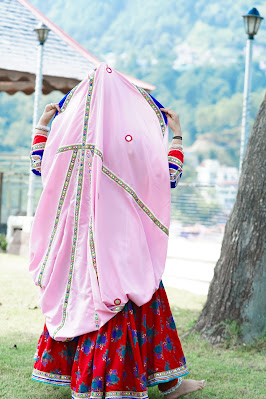



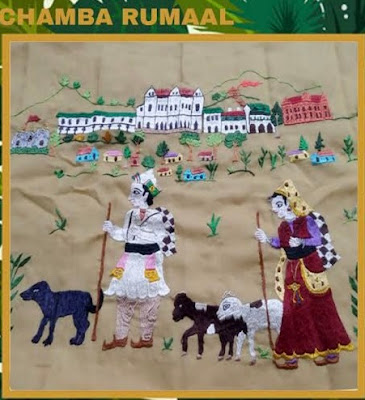







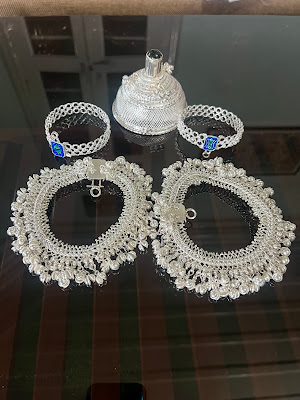




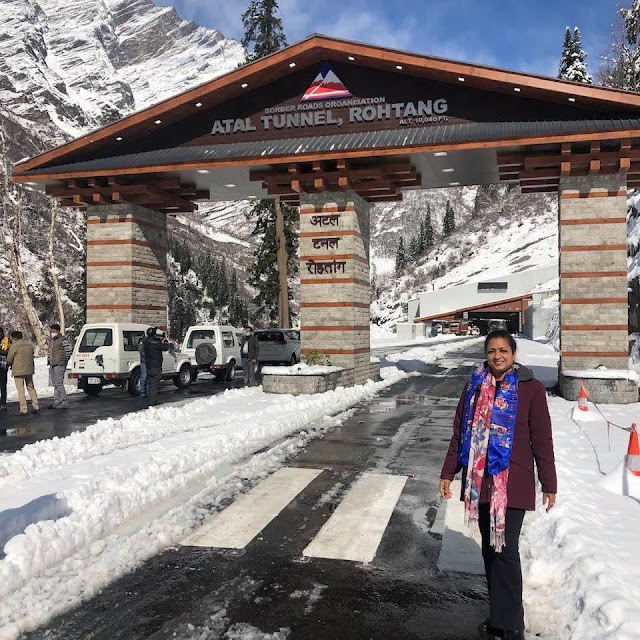
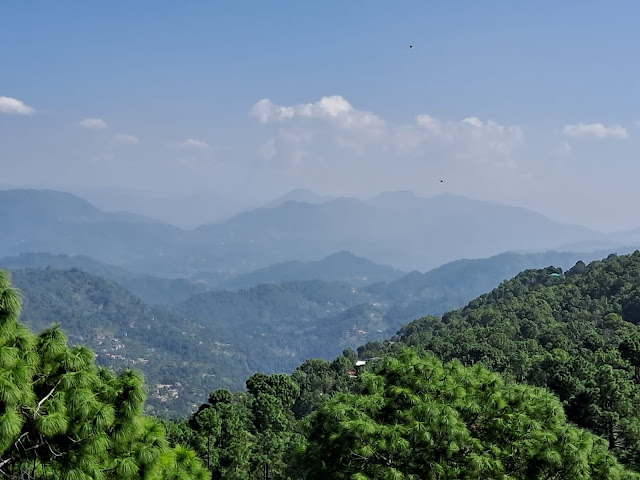
What an excellent piece, written with so much love and gives an in-depth analysis of the tribe✨
ReplyDeleteYour passion for traditional attires truly resonates with me. I loved your insightful write-up and meticulous research on the Launchari, Chamba's exquisite traditional dress. The decision to adorn it firsthand was a brilliant way to immerse yourself in its cultural essence. A truly commendable effort in preserving and celebrating our rich heritage!
ReplyDeleteGrateful to you Mam for presenting the Himachali attire and culture in a beautiful, eye-catching and elegant way.🙏🙏🙏
ReplyDeleteNicely depicted about the Launchari. Maam u visualise things so differently. Thanks.
ReplyDeleteExcellent depiction of Gaddi tribe, and their attire jwellery shoes and, your passion for Launchan tribe, Anurita commendable effort by you, keep on posting such incidiblbe research work .proud of you
ReplyDeleteThere can't be a better display of love of the culture we love & live within & you have have amply displayed with this deeply passionate passage. Kudos.....
ReplyDeleteWhat a wonderful blog with interesting information so creatively curated .
ReplyDeleteBeautiful Blog and Beautiful Pictures Mam.
ReplyDeleteMadam, I worked in Chamba for so long but didn’t know much about traditional dress of Gaddi women, despite the fact that I have seen women wearing it so many times. Was delighted to read about it all . Thanks for sharing.
ReplyDeleteThanks a lot everyone
ReplyDeleteIt’s heartening to go through this blog celebrating this fascinating community. Preserving and sharing legacy of Gaddans may inspire future generations to appreciate their simple yet beautiful way of life… God bless you more and more inspirational stories.
ReplyDeleteV well Explained Dresses of Gaddians and jewelry like chanderhaar main baat you r looking so pretty in this dress stay blessed
ReplyDeleteHimachal Pradesh is known for following its age old cultural praxes and societal mores which are found in different regions of Himachal Pradesh.After visiting and seeing the entire Himachal especially tribal areas i.e.Kinnaur,Lahaul Spiti,Dodra Kwar,Pangi and Bharmour , you must have seen not only the multeity in terms of wearing traditional toggeries but also the salmagundi of local customs and totemic elements quite pervasive in these areas.
ReplyDeleteYour description about Luanchari ,a traditional Gaddi dress looking so comely ,is again based on your practical demonstration by wearing it yourself.It all goes to show that you have a puissant knack for traditional things which are aptly elucidated through your blogs .
Thanks a lot
DeleteSo well researched. It is colourful, I'm impressed.
ReplyDeleteExcellent blog with good and bright pics on Gaddis , pastorals of Kangra Chamba .
ReplyDeleteSo very well explained....with clear pictures....your blogs are window to himanchali culture....
ReplyDeleteTishya